You'll find fermenting vegetables in a crockpot surprisingly simple with these five methods. First, try the basic dry salt method by massaging salt into shredded cabbage for sauerkraut. Second, create a simple salt brine for cucumbers and carrots using a 2.5% ratio. Third, layer whole vegetables with herbs and spices, then cover with brine. Fourth, use the progressive layering technique by alternating vegetables with salt. Fifth, try the natural fermentation method by letting vegetables create their own brine through salt extraction. Each method requires proper weight distribution and anaerobic conditions for success, and there's much more to explore about fermentation's endless possibilities.
Essential Crockpot Fermentation Equipment
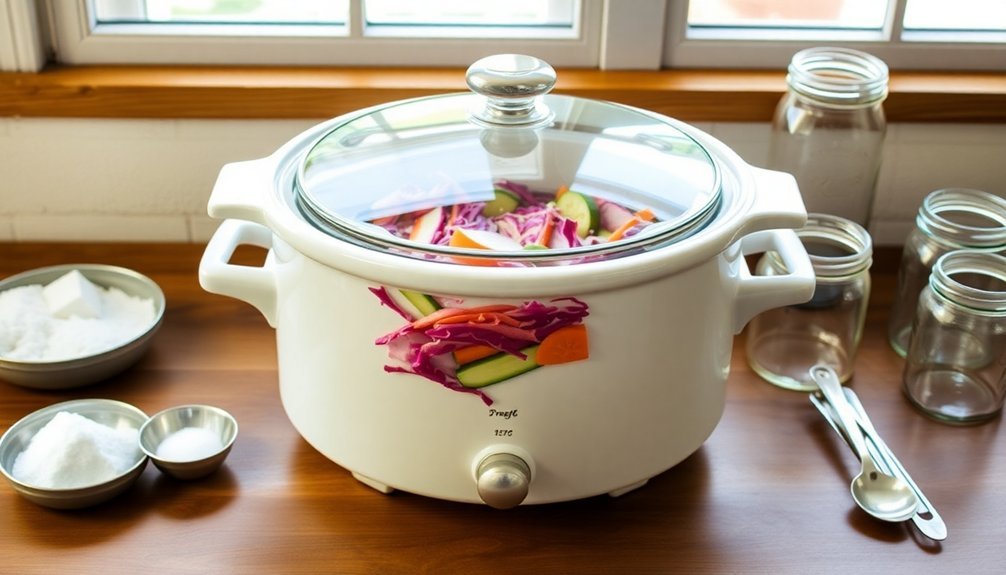
Getting started with crockpot fermentation requires several essential pieces of equipment to guarantee successful results. You'll need a high-quality stoneware or ceramic fermentation crock, preferably cylinder-shaped for easy access. These crocks, crafted with lead-free glazes, ensure safety while fermenting your vegetables. Choose between open crocks or water-sealed versions, available in 2, 3, or 5-gallon capacities depending on your batch size requirements.
You'll also need proper weights and lids to maintain an anaerobic environment. Stone weights keep vegetables submerged under the brine, while lids can be semi-circular or plate-like. If you're using an open crock, you can use a towel cover, but water-sealed crocks require specific lids with water-filled moats.
Don't forget essential tools like a wooden cabbage stamper for packing vegetables, a knife and cutting board for preparation, and a sauerkraut pounder for compression. For smaller batches, you might prefer glass weights with easy grips and canning lids for glass jars.
Regular maintenance is vital for successful fermentation. You'll need to monitor water levels in sealed crocks, check for overflow in open crocks, and maintain room temperature conditions away from direct sunlight.
Always clean and sanitize your equipment before and after use to prevent contamination.
Understanding Salt Brine Ratios
You'll need to master the basic 2.5% salt-to-water ratio for successful vegetable fermentation in your crockpot, which means using about 2 tablespoons of salt for every 4 cups of water.
Different vegetables might require slight adjustments to this ratio, with softer vegetables typically needing less salt and harder vegetables requiring more. Using a kitchen scale for measurement will ensure the most accurate salt concentration for safe fermentation.
When measuring your salt, it's vital to use pure, non-iodized salt without additives to guarantee proper fermentation and avoid any off-flavors in your finished product.
Basic Salt-Water Proportions
Salt-water proportions form the cornerstone of successful vegetable fermentation. You'll need to understand that a 2% salt concentration works best for most vegetable ferments, though you might need higher concentrations (3-10%) for vegetables like cucumbers and olives to maintain their crunch. Iodized salt should be avoided since it can alter the taste and appearance of your fermented vegetables.
To calculate your brine accurately, you'll need to weigh both your vegetables and water in grams. For every 1000 grams (1 liter) of total weight, you'll need 20 grams of salt to achieve a 2% concentration. Remember that vegetables contain 92-98% water, which affects your final calculations.
| Jar Size (ml) | Salt for 2% Brine (g) | Salt for 5% Brine (g) |
|---|---|---|
| 500 | 10 | 25 |
| 750 | 15 | 37.5 |
| 1000 | 20 | 50 |
| 1500 | 30 | 75 |
| 2000 | 40 | 100 |
You can either mix your brine separately before adding it to your vegetables or add salt directly to your jar of vegetables before filling it with water. If you're mixing the brine separately, use a slightly higher concentration to account for the water content in your vegetables.
Adjusting For Different Vegetables
Different vegetables demand specific salt concentrations to achieve ideal fermentation results. When you're using your crockpot for fermentation, you'll need to adjust your salt ratios based on the vegetable type.
While most vegetables ferment well within a 2-5% salt concentration range, specific varieties require precise measurements for best results.
For cucumbers, you'll want to use a stronger brine of 3.5-5% to maintain crispness, while broccoli and cauliflower need a gentler 2-2.5% solution. If you're fermenting garlic, aim for a 3% brine, and for olives, you'll need to increase it substantially to 10%. Make sure to use filtered water to avoid chlorine that could harm beneficial bacteria.
You can calculate the exact amount by weighing your vegetables and water, then multiplying by your desired percentage to determine how many grams of salt to add.
If you're not keen on precise measurements, you can follow the general rule of 1-3 tablespoons of salt per quart of water. However, be careful not to use too little salt (below 2%), as this can lead to spoilage, or too much (above 5%), which can halt fermentation altogether.
For consistent results, consider using a digital scale to measure your salt accurately.
Choosing The Right Vegetables
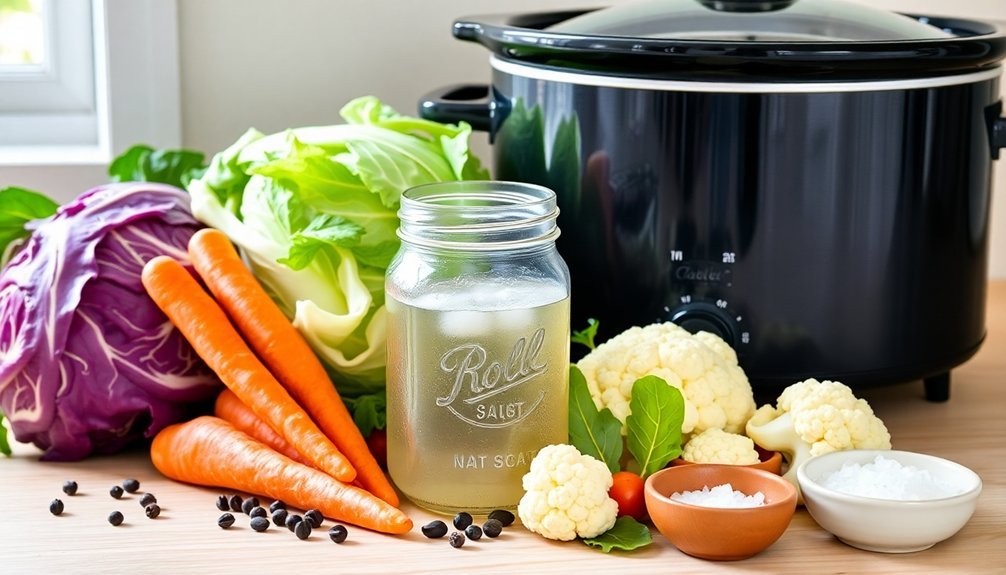
When starting your fermentation journey, selecting the right vegetables is essential for success. You'll want to focus on vegetables with high moisture content, such as cucumbers, cabbage, carrots, and beets. These vegetables naturally create an effective brine during fermentation and maintain their texture throughout the process.
For the best results, choose fresh, crisp vegetables that you'll cut into smaller pieces. Finely chopped or grated vegetables ferment more effectively because they've increased surface area for the beneficial bacteria to work on. For cabbage specifically, aim to shred it to a quarter inch thickness for optimal fermentation results.
You can also experiment with classic combinations like cabbage and carrots for sauerkraut, or cucumbers and dill for traditional fermented pickles.
Before placing your vegetables in the crockpot, you'll need to properly prepare them. Wash them thoroughly to remove dirt and contaminants, then peel and core as needed.
Remember to weigh your vegetables to calculate the correct amount of salt for your brine. When loading your crockpot, make certain all vegetables remain completely submerged in the brine to prevent spoilage.
You can use outer cabbage leaves as a natural barrier to keep other vegetables below the surface.
Basic Dry Salt Method
Starting with the dry salt method provides an efficient way to ferment vegetables in your crockpot.
You'll need to calculate 2% of your vegetables' total weight to determine the right amount of salt. For example, if you're using 1 kg of vegetables, you'll need 20g of salt.
Begin by finely chopping or grating your vegetables, then sprinkle them with the measured salt. Let them sit for 10-15 minutes, allowing the salt to draw out their natural moisture and create a brine. Using this method helps break down cell walls and facilitates the release of natural juices. You'll notice the vegetables becoming wet and releasing water during this process.
Pack your salted vegetables tightly into your crockpot using a tamper or pickle packer. You'll want to guarantee they're compressed enough to be fully submerged in their natural brine. Don't leave large air gaps, as this can lead to spoilage.
While you can adjust the salt ratio between 1.5% and 2% for most vegetables, sticking to 2% provides the best balance for successful fermentation.
You'll need to monitor your ferment for 5-14 days, depending on your desired flavor profile. When it's ready, transfer it to mason jars and store them in your refrigerator.
Simple Vegetable Brining Technique
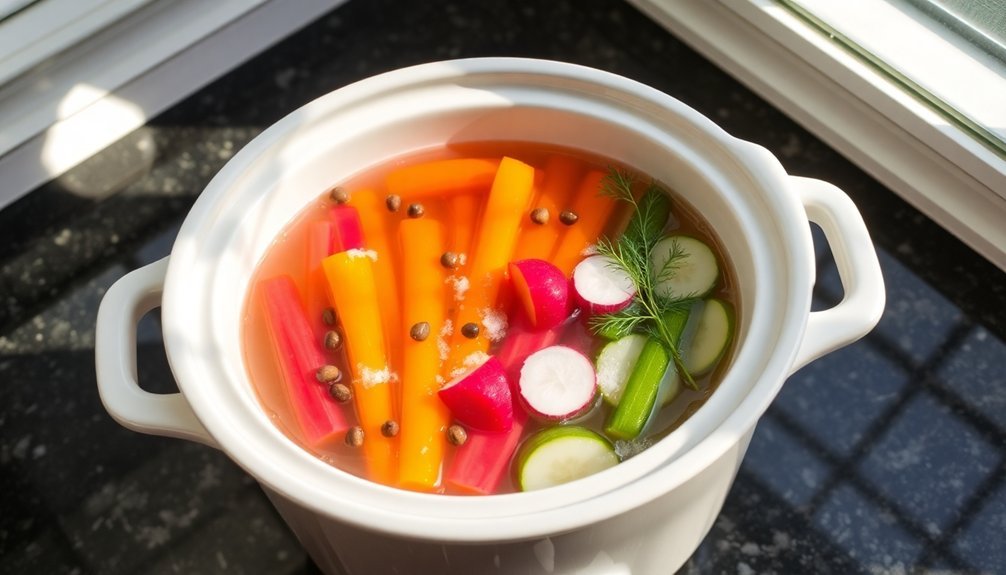
You'll find that the simple vegetable brining process starts with a basic ratio of 1/2 cup salt per gallon of unchlorinated water, though cucumbers may need up to 3/4 cup for the best firmness.
Before adding brine, stir vigorously until all salt has completely dissolved in the water.
To prep your vegetables, pack them into your clean crockpot while leaving headspace at the top, and make certain you've removed any air bubbles that could lead to unwanted mold growth.
Top your packed vegetables with a large leaf or fermentation weight to keep everything submerged in the brine, which is essential for successful fermentation.
Basic Salt Brine Ratios
Creating the right salt brine ratio stands as one of the most essential elements in successful vegetable fermentation.
You'll need to maintain a standard salt concentration of 2.5% for most vegetables, though this percentage varies by type. For cucumbers, you'll want to increase the ratio to 3.5-5%, while broccoli requires a lower 2-2.5% concentration.
For a practical approach, you can use 1-3 tablespoons of salt per quart of water as a general guideline. This method has proven effective as ancient civilizations used similar ratios to preserve their food supplies.
If you're working with hard vegetables, you'll need to prepare a separate brine solution by mixing water and salt before adding your produce. For water-rich vegetables, you can simply sprinkle salt directly over them to draw out their natural moisture.
When using your crockpot, remember that moderate temperatures around 20-22°C work best for brining. You can measure about ½ cup of salt per gallon of unchlorinated water for most vegetables, though cucumbers may need up to ¾ cup for ideal firmness.
Always use precise measurements – too little salt risks contamination, while too much will inhibit the fermentation process you're trying to achieve.
Vegetable Prep Steps
Proper vegetable preparation forms the foundation of successful fermentation in your crockpot. You'll need to start by thoroughly cleaning your vegetables and equipment to prevent any unwanted contamination that could spoil your ferment.
Once clean, chop or shred your vegetables according to your preference – smaller pieces will release more water and help kickstart the fermentation process.
When you're ready to pack your crockpot, choose dense vegetables like carrots, cabbage, or radishes, as they'll maintain their texture better during fermentation. Pack the vegetables tightly to eliminate air pockets, which can lead to mold growth.
If you're using vegetables with high water content, you'll want to salt them directly and let them release their natural juices. For denser vegetables, you'll need to prepare a separate brine solution.
As you layer the vegetables, press them down firmly to remove any trapped air bubbles. Make sure you've got enough vegetables to fill your crockpot to about 80% capacity, leaving room for the brine and potential expansion during fermentation.
You'll want to keep the vegetables completely submerged throughout the process to guarantee even fermentation.
Essential Container Setup
Success in vegetable fermentation hinges on the right container setup and brining technique.
You'll need a glass, ceramic, or crockpot container that's been thoroughly cleaned and sterilized. Mason jars with lids work well, but avoid using any porous materials that could harbor unwanted bacteria.
To create your brine, mix 1/2 cup of salt per gallon of unchlorinated water. If you're fermenting cucumbers, increase this to 3/4 cup of salt for better firmness. You can add optional spices to enhance flavor.
Layer your vegetables in the container, then pour the brine over them until they're completely submerged.
Keep your vegetables under the brine by using a weight or large leaf as a barrier. This step is essential for successful fermentation.
Remove any air bubbles and secure the lid loosely to allow gases to escape.
Place your container in a warm kitchen where temperatures stay between 20°C and 22°C.
Monitor your fermentation daily for 3 to 7 days, depending on how sour you want your vegetables. You'll know it's ready when the brine turns cloudy and the vegetables develop that characteristic fermented tang.
Maintaining Proper Temperature Control
Temperature control stands as one of the most critical factors in vegetable fermentation, with the ideal range falling between 60°F and 70°F (16°C to 21°C). You'll find that 65°F (18°C) provides the best conditions for balanced bacterial growth and flavor development.
| Temperature | Effect on Fermentation |
|---|---|
| Below 58°F | Slows process, risks mold growth |
| 60-70°F | Ideal range for quality results |
| 65°F | Perfect balance for beneficial bacteria |
| Above 70°F | Too rapid, compromises quality |
To maintain proper temperature, you'll need to adjust your fermentation time based on your environment. If you're working in a warmer space, consider adding extra salt and shortening the fermentation period. In cooler conditions, expect longer fermentation times.
You can maintain consistent temperature by using a water-sealed crockpot with an airlock. Monitor your fermentation regularly and make adjustments as needed. Temperature fluctuations shouldn't exceed 5 degrees in either direction. If you're serious about precision, invest in temperature control equipment or create a controlled environment. Remember to taste your ferments regularly to catch them at their peak flavor development.
Signs of Successful Fermentation
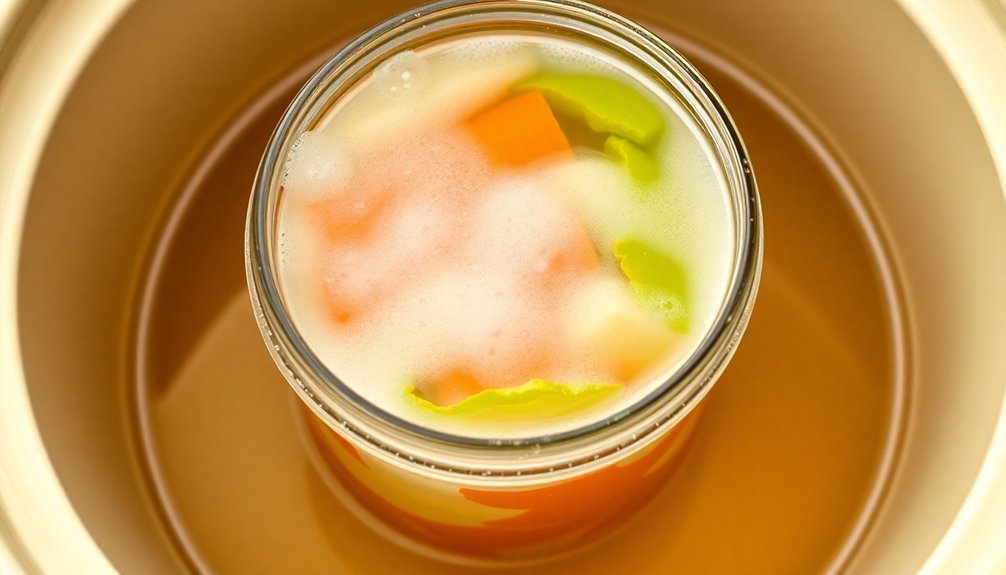
During the fermentation process, you'll notice several key indicators that signal your vegetables are transforming properly. The most visible sign is the formation of bubbles in your crockpot, which indicates active fermentation as carbon dioxide is released. You'll typically see this bubbly activity after a few days at room temperature.
Your nose will help you determine success too. You should detect pleasantly tangy or slightly sour aromas. If you smell anything rotten or moldy, that's a clear sign something's wrong.
The brine in your crockpot may become cloudy, which is perfectly normal and actually indicates active fermentation.
When you taste your fermenting vegetables, they should have a tangy, acidic flavor while maintaining some crunchiness. Don't worry if different vegetables develop distinct tastes and textures – that's expected.
You'll also notice subtle color changes, such as cabbage becoming slightly lighter, but watch out for dark spots or unusual discoloration.
Remember that bubble formation can vary between different vegetables, and the absence of bubbles doesn't always mean failure. Trust your senses – if the aroma is pleasant and the taste is tangy, your fermentation is likely successful.
Common Fermentation Problems
Three critical issues can derail your vegetable fermentation: imbalanced salt levels, inadequate submersion, and poor environmental conditions.
When your salt ratio isn't between 1-3 tablespoons per quart, you'll either fail to inhibit harmful bacteria or halt beneficial microbial growth.
Keeping vegetables fully submerged is vital – any exposure to air can lead to mold and yeast growth.
You'll also need to maintain a temperature around 72°F and verify proper sanitation of your equipment.
To troubleshoot problems effectively, check your ferments regularly for signs of failure. If you spot green, blue, brown, or black mold, or detect a putrid smell, dispose of the batch immediately.
Monitor the pH level to verify it stays below 4.6, and use airlocks to manage gas buildup.
- Always use clean, sterilized equipment before starting a new batch
- Check the submersion level daily and adjust weights as needed
- Monitor temperature fluctuations, especially during seasonal changes
- Keep detailed records of salt ratios and fermentation progress
- Test pH levels regularly using strips or a digital meter
Adding Herbs and Spices
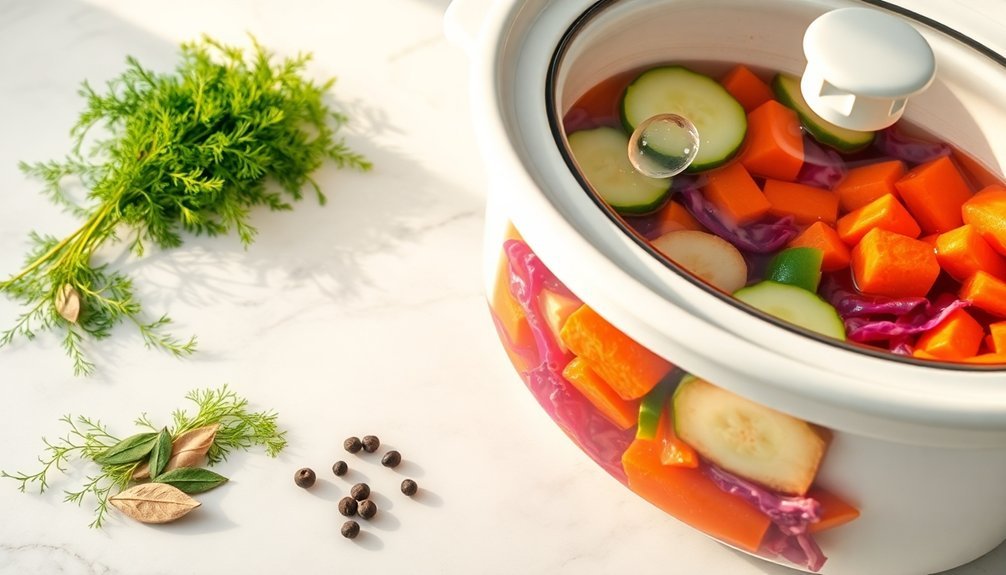
Enhancing your fermented vegetables with herbs and spices can transform an ordinary batch into something extraordinary. You'll want to start with a basic mix of mustard seeds, fennel seeds, black peppercorns, and bay leaves as your foundation.
From there, you can experiment with additional flavors like dill, garlic, ginger, or chili peppers.
When adding herbs and spices to your crockpot, use about 1 tablespoon of fresh herbs or 1 teaspoon of dried spices. Layer your seasonings strategically, starting with aromatic spices like garlic at the bottom of your container.
You can add whole fresh herbs for both visual appeal and flavor infusion, or chop them finely to distribute the taste more evenly.
Don't forget to think about wild greens like dandelion or nettles, which work well in dry-salted ferments. If you're adding spicy elements like chili flakes, you might need to use more than usual since fermentation can reduce their intensity.
For consistent results, make sure you're distributing your herbs and spices evenly throughout the vegetables, either by gentle mixing or massaging them together to release natural juices.
Long-Term Storage Methods
Proper storage techniques guarantee your fermented vegetables maintain their quality and flavor for months. Once your vegetables reach the desired level of sourness after 4-5 days of fermentation, you'll need to move them to a cool storage location.
Your refrigerator, basement, or root cellar are ideal spots, as lower temperatures slow down the fermentation process without stopping it completely.
Always make certain your vegetables remain submerged under the brine by using fermentation weights or cabbage leaves. Switch out the fermenting lids for regular ones, and don't forget to label your jars with dates.
When handling your ferments, use clean hands and sterilized utensils to prevent contamination.
- Store ferments at temperatures between 32-50°F (0-10°C) for best preservation
- Keep vegetables fully submerged in brine to prevent mold growth
- Check containers weekly for proper seal and brine levels
- Use clean utensils each time you access your ferments
- Consume within 6-12 months for best quality, though they'll last longer if properly stored
Remember to pack your vegetables tightly and eliminate air bubbles before storage. Regular monitoring of brine levels will help maintain the quality of your fermented vegetables throughout their storage life.
Health Benefits of Fermented Vegetables
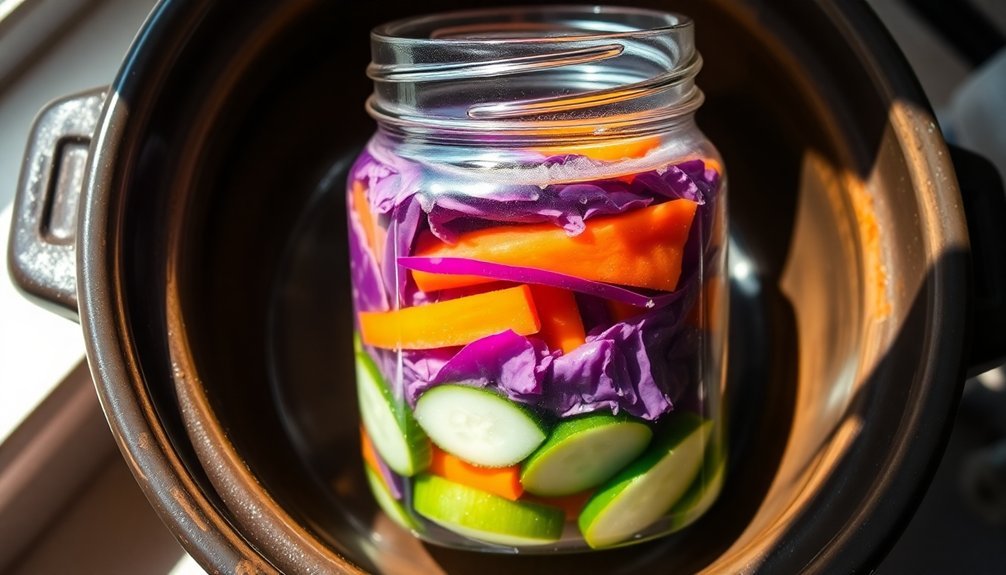
Your gut health flourishes when you add fermented vegetables to your diet, as these probiotic powerhouses help break down nutrients and support beneficial bacteria in your digestive system.
The natural fermentation process creates an environment where good bacteria thrive, leading to improved digestion and enhanced nutrient absorption that directly benefits your overall wellness.
These beneficial microorganisms also strengthen your immune system by reducing inflammation and supporting your body's natural defense mechanisms.
Gut Health Powerhouse
Four powerful health benefits make fermented vegetables a true gut health powerhouse. When you consume fermented vegetables regularly, you'll enhance your gut microbiome's diversity while stimulating beneficial bacteria that produce essential nutrients like butyrate.
The fermentation process helps predigest food components, making nutrients more bioavailable and easier for your body to absorb. You'll also notice reduced inflammation throughout your body, as fermented foods decrease inflammatory proteins and support a balanced immune response.
The impact on your digestive system goes beyond basic nutrition. You'll experience improved digestion and fewer gastrointestinal issues, as fermented vegetables help break down complex molecules and reduce problematic compounds that cause flatulence.
- Your gut microbiome becomes more diverse, leading to better production of crucial compounds like acetate and propionate
- You'll absorb more nutrients since fermentation increases bioavailability of vitamins C, B, and K
- Your digestive system works more efficiently with pre-digested food components
- You'll experience reduced inflammation and improved immune responses
- Your risk for metabolic conditions and heart disease decreases through better cholesterol management
Natural Immune System Boost
Beyond their digestive benefits, fermented vegetables pack a powerful punch for immune system strength. When you eat these foods, you're stimulating and supporting the beneficial bacteria in your gut that produce essential nutrients for your immune cells.
The fermentation process creates butyrate, a short-chain fatty acid that feeds and repairs your gut lining, directly strengthening your immune defenses.
You'll benefit from the lactic acid bacteria in fermented vegetables, which synthesize vitamins and produce active peptides and enzymes. These compounds work together to provide anti-inflammatory, anti-microbial, and anti-oxidant effects.
Studies show that consuming fermented foods can boost your microbiome diversity and improve your immune responses, while reducing inflammation throughout your body.
What makes fermented vegetables particularly effective is their natural fiber content, which feeds your gut microbiome. Research confirms that high-fiber fermented foods can work synergistically to enhance your immune system.
You'll also find that fermented vegetables like kimchi can help reduce your blood cholesterol levels. With proper fermentation techniques controlling microbial growth and pH levels, you're getting a safe, scientifically-backed way to strengthen your natural immunity.
Traditional Vegetable Fermentation Recipes
Traditional vegetable fermentation brings centuries-old wisdom to your kitchen through time-tested recipes that have preserved food across cultures.
You'll find that basic fermentation recipes typically call for 1-3 tablespoons of sea salt per 4 cups of filtered water, creating the perfect environment for beneficial bacteria to thrive.
When you're working with vegetables like cabbage, carrots, or green beans, you'll want to guarantee they're completely submerged in this brine solution.
To enhance your fermented vegetables' flavor profile, you can incorporate classic combinations of garlic, dill, peppercorns, and other aromatic herbs.
Remember to maintain a consistent temperature between 60-75°F during the 3-5 day fermentation period.
- Layer shredded cabbage with salt for traditional sauerkraut, tamping down firmly between layers
- Combine sliced carrots with garlic and dill for a Russian-inspired ferment
- Mix cauliflower florets with peppercorns and bay leaves for a classic pickle
- Create mixed vegetable medley with green beans, asparagus, and beets
- Prepare cucumber pickles with grape leaves to maintain crispness
Monitor your ferment daily, releasing any built-up gases and checking for proper vegetable submersion beneath the brine.
Safe Handling Practices
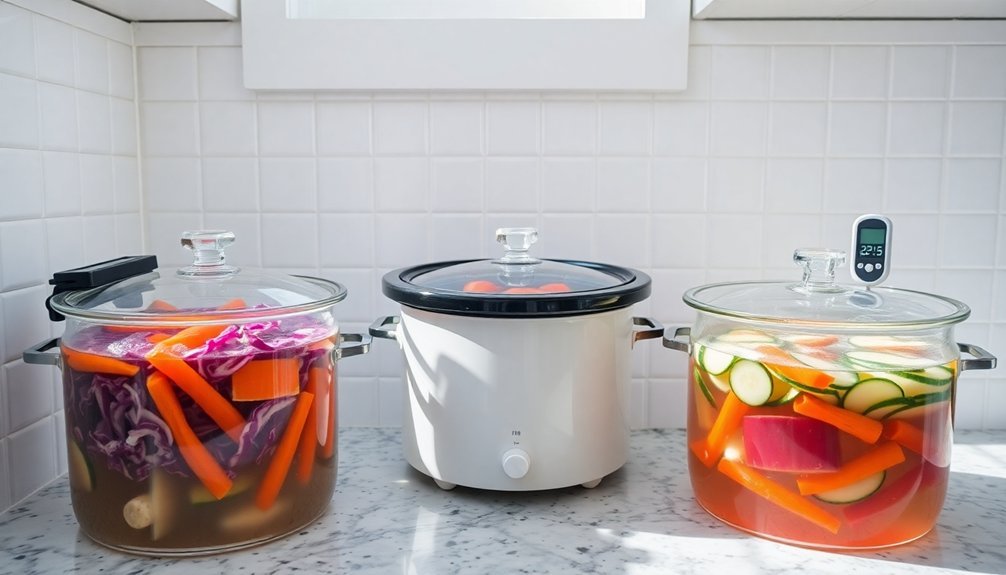
Proper safety protocols form the foundation of successful vegetable fermentation. When using your equipment, you'll need to start by thoroughly cleaning all equipment with hot soapy water. Don't forget to use only food-grade, acid-resistant containers for your fermentation process.
Before you begin, select fresh vegetables that are free from mold and dirt. You'll want to cut them uniformly to guarantee even fermentation, and don't prepare them more than 24 hours before starting the process.
For vegetables like carrots and olives, you'll need to pre-treat them with a lye wash followed by a thorough rinse.
During fermentation, keep your vegetables fully submerged in brine using weights to maintain anaerobic conditions. You'll need to monitor the pH levels regularly, aiming for a reading between 3 and 4.
Keep your fermentation area at 20-22°C (70-75°F) for ideal fermentation.
Once fermentation is complete, store your products properly. If they're not pasteurized, keep them refrigerated. Always check for signs of spoilage like scum formation or off odors.
Remember to use non-iodized salt and avoid metal containers that might react with your fermented foods.
Frequently Asked Questions
Can I Reuse the Brine From a Previous Batch of Fermented Vegetables?
Yes, you can reuse brine from fermented vegetables. Add 1/2 cup for quart or half-gallon jars, or 1 cup for gallon jars. Just use it within a couple weeks for best probiotic benefits.
Why Do Some Vegetables Float Even With Weights in Place?
Your vegetables float even with weights because they're releasing carbon dioxide during fermentation. You'll notice gas bubbles getting trapped in vegetable layers, making them buoyant despite the weight's pressure.
Does Electricity Usage Affect Fermentation When Using a Crockpot's Warming Function?
Your crockpot's warming function can affect fermentation if it keeps temperatures too high. You'll want to monitor it closely, as excessive heat above 75°F can speed up fermentation and alter the results.
Are Plastic Crockpot Liners Safe for Fermentation Projects?
You shouldn't use plastic crockpot liners for fermentation. They can leach harmful chemicals, especially with acidic foods. Instead, opt for ceramic crocks, stainless steel, or non-toxic clay pots for safer fermentation projects.
Can I Mix Different Batches of Fermented Vegetables After They're Done?
Yes, you can mix different batches of fermented vegetables once they're done. Just make sure they've fermented for similar periods and are properly stored. Watch for consistent taste and texture in your mixed combinations.
In Summary
You'll find that fermenting vegetables in your crockpot is both rewarding and straightforward once you've mastered these basic techniques. By maintaining proper salt ratios, selecting fresh vegetables, and following safe handling practices, you're well-equipped to create delicious, probiotic-rich foods at home. Don't forget to properly store your fermented creations to enjoy their tangy flavors and health benefits throughout the year.

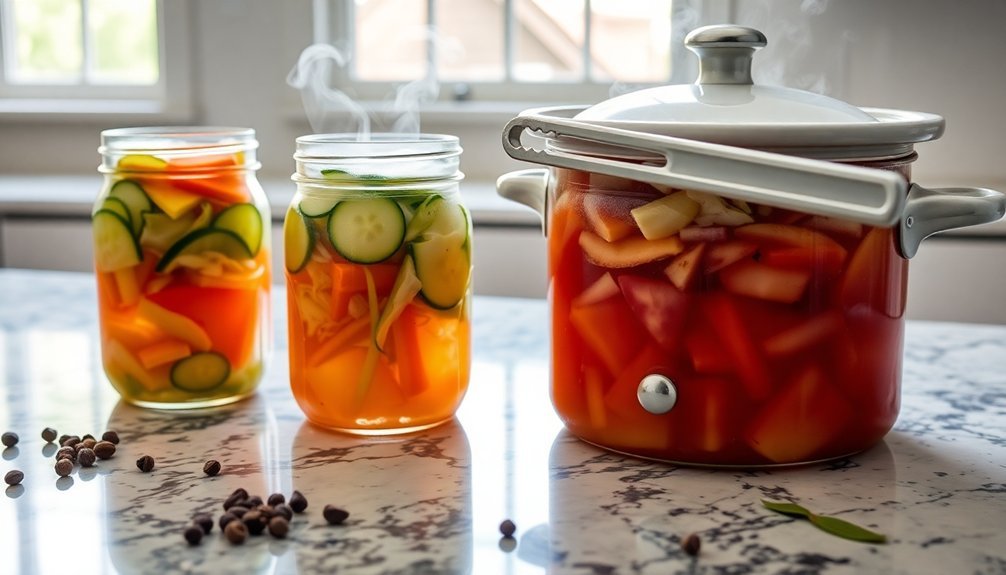



Leave a Reply